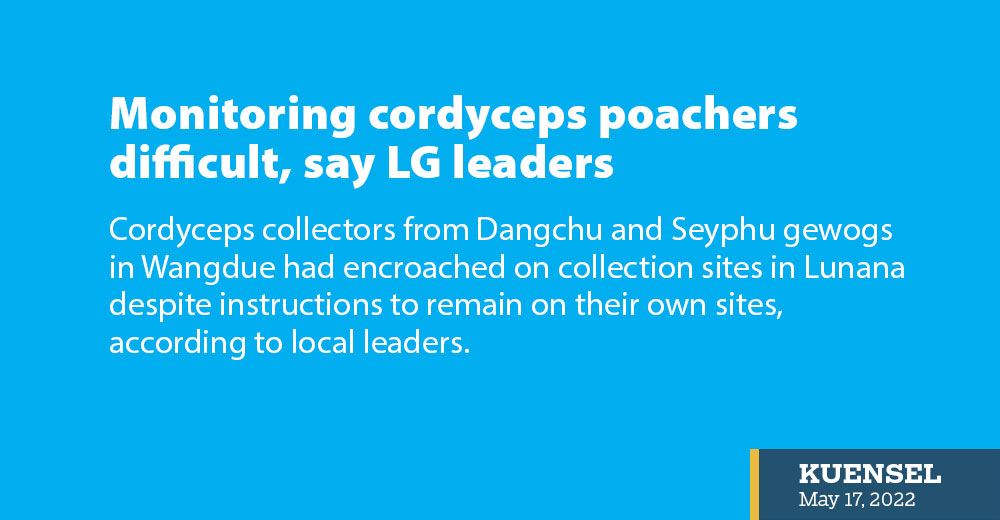Staff Reporter
Cordyceps collectors from Dangchu and Seyphu gewogs in Wangdue had encroached on collection sites in Lunana despite instructions to remain on their own sites, according to local leaders.
Dangchu Gup Phub Dorji said collectors violated the demarcated area because the yield in their designated area is not as good as in Lunana. “People are at fault for encroaching on others’ land and they have to move out,” he said.
Local leaders in Seyphu and Dangchu gewogs agree that the incident last week that led to the death of an illegal collector could have been prevented if collectors respected the rules and regulations. Gup Phub Dorji said that the collectors are constantly reminded not to violate the rules (illegally collecting from other places) “The bountiful harvest in Lunana which happens every four years attracted poachers,” he said.
Phub Dorji added that he has been asking people in his gewog to move out of Lunana and respect the rules of harvesting cordyceps. In his gewog, there are about 12 collection sites. The gewog issued 181 permits this year.
Rules and regulations for harvesting cordyceps state that collectors can only harvest within their administrative jurisdiction. Only three individuals from a household are eligible for collection. Violators have to pay compensation at market value or according to compensation schedules fixed by the agriculture ministry, or the cordyceps are confiscated.
Gup Phub Dorji said the collection area in Lunana is about three kilometres’ walk from where the poachers were allowed to harvest. “Collectors intrude or violate rules when they cannot collect enough in their designated area,” he said.
Asked why the illegal collectors were not monitored, Sephu gup Dawa Tshering said that the local leaders cannot go after every individual to see if they are illegally harvesting cordyceps. “It would be impossible to go to each of the places to monitor or go after each collector,” he said, adding that they carry out awareness of the rule through all means including social media groups.
The collectors get the permit to collect in their designated area and intrude to other areas as the area is vast and monitoring becomes difficult.
“The whole problem would have been prevented if people had not crossed the line,” he said, adding that the prospect from the bumper harvest this year and past trends made people poach cordyceps in Lunana. Seyphu gewog administration issued 635 permits to the people of Sephu, Gangtey, and Thangye villages in Trongsa.
There are about 300 illegal collectors in Lunana when the problem started.
On May 14, a cordyceps poacher died from injuries after a confrontation between security personnel on patrol and the illegal collectors. The agriculture ministry through a press release stated that poachers pelting stones injured another collector. After examining the wound on the head, the Health Assistant of Lunana BHU confirmed that he was injured by stones thrown by the poachers and not by a stray bullet as previously thought, according to the press release.
The illegal collectors assaulted the armed force personnel and attempted to snatch their weapons, while others began pelting stones from higher ground, the press release stated. Nine of the patrol team members received various injuries from the stones and direct assault. One of the foresters in the team was hit on the head with a sheathed knife.
To prevent escalations, the 12 RBA personnel including the military doctor, five foresters, and 70 Lunaps who had permits to collect cordyceps in their own area vacated their camps on May 14, leaving behind all their items fearing getting assaulted by poachers.


